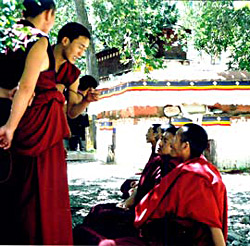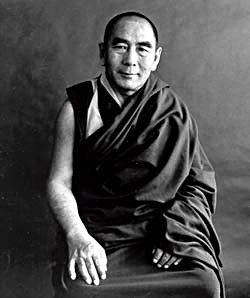by José Ignacio Cabezón and THL.
Textualists and Workers
From the viewpoint of what we might call vocation, there were two types of monks at SeraSe ra:

Textualist monks debate in the debate courtyard of the Jé College, SeraSe ra-Tibet.
- monks who engaged in studies, called “textualists” (pechewadpe cha ba), and
- those who engaged in the day-to-day work of the monastery, or more simply “workers.”21
By some estimates, less than 25 percent of all the monks living at SeraSe ra were textualists. Textualists generally had a higher status than worker monks, both in the monastery and in the society at large. They were perceived as engaging in the type of work for which a monk’s life was intended: study and prayer. This does not mean that they were pampered or uncritically revered. If a textualist got out of line – for example, if he took advantage of workers or became too full of himself – even an uneducated worker monk would be quick to put him in his place.22 Textualists tended to be poorer than worker monks because they spent their free time memorizing and studying, and were thus unable to engage in business or other forms of work to augment their income. Within the category of textualist, monks were further distinguished according to the level they had reached in the curriculum. Monks in the more advanced classes had greater privileges than those in the lower classes, and monks who had completed their studies and who had been awarded the geshédge bshes degree occupied one of the highest positions in the monastery, second only to lamabla mas. There were also different ranks of geshésdge bshes – depending upon whether the degree had been granted internally by the college (rikramrigs ram), by the monastery’s two philosophical colleges jointly (lingsepgling gseb), or whether it had been granted by the Tibetan government in public examinations (tsokramtshogs ram and lharamlha ram).23 Of the monks who completed the geshédge bshes degree many would return to their home monastery to teach. Some would enter retreat. If they had been awarded the higher geshédge bshes degree, they could enter one of the two Tantric Colleges (usually for a two-year period, at the end of which they could either return to SeraSe ra, go into retreat, or else return to their home monastery). Some geshésdge bshes would simply remain at SeraSe ra and teach after getting their degree.

Geshe Sopa (Geshé ZöpaDge bshes bzod pa), a geshé lharampadge bshes lha ram pa, and one of the most senior geshésdge bshes of SeraSe ra. He lives in Madison, Wisconsin, and is professor emeritus at the University of Wisconsin.
Click one one of the following links to:
- Read an account of the education of textualists in the densagdan sas, a selection from a book by Prof. Georges Dreyfus
- Read an excerpt from the life of an eminent, contemporary textualist monk, Geshe Rabten (Geshé RaptenDge bshes rab brtan)
- See the daily schedule that a textualist monk traditionally followed.
Workers were of various types. Some worker monks spent their time in various ventures that supplied them with money for living expenses: for themselves and for the members of their household (shaktsenshag tshan). Others worked for wealthier monks – for example, in lamabla mas’ households (labrangbla brang) – where they were provided for. Some monks worked for the various administrative units of the monastery: for regional houses (khangtsenkhang tshan), colleges (dratsanggrwa tshang) or for the SeraSe ra Lama Society (lachibla spyi). Some worked outside the monastery. Monks engaged in a variety of work:
- Kitchen work:
- cooking
- purchasing supplies
- overseeing monk-cooks or hired kitchen staff
- serving tea and food in assemblies
- Serving as caretakers of temples or chapels:
- making offerings on the altars
- cleaning
- receiving the offerings made by pilgrims and worshippers
- serving as guards to ensure that nothing was stolen from altars
- accounting for the goods and money received
- selling religious goods (protection amulets, blessed pills, etc.)

A worker monk in the Tantric College kitchen pours tea into pitchers that will be used to serve the monks in the assembly.
- Serving as part of the ritual staff in specific chapels:
- meeting with prospective patrons who wanted to commission rituals, and providing them with a financial accounting after the fact
- preparing for the ritual (buying the necessary offerings, making ritual cakes, etc.)
- enacting the ritual
- Working as servants or hired-help:
- within the monastery (to lamabla mas, senior teachers, wealthy monks, and administrators)
- outside the monastery (in restaurants, on farms, and in other businesses)
- As artisans, craftsmen, musicians or skilled laborers:
- painting (tangkathang ka, statues, wall murals, etc.) (lhadripalha bris pa)
- building statues (lhazopalha bzo ba)
- serving as musicians (rölyangparol dbyangs pa)
- printing texts
- supervising construction projects
- Engaging in business:
- trading (both locally and in outlying districts)
- banking (lending money for interest)
- safeguarding the jewelry or other precious objects that were left as collateral by those who borrowed money
- debt/loan collection
- accounting
- tending the estates (of wealthy lamabla mas, and of the various administrative subunits of the monastery), either as workers or as overseers.

A young monk works with a woodblock from which he will print a text.
Many of these forms of work were looked down upon. They were seen as inappropriate for monks, and even before 1959 there were attempts to reform the monasteries, encouraging monks to give up things like money-lending.24 For the most part, however, these attempts at reform were not heeded. You can learn more about each of these forms of work under Activities.
Many workers were dopdopldob dlobs. These were worker monks who organized themselves into fraternities. These fraternal units – or “parks” (lingkagling ka), as they were called – inducted members, did morning group physical workouts, met together for food and ritual, and sporadically convened inter-fraternity athletic competitions. They wore their clothes in a special fashion, donned side-locks, walked with a swagger, and wore special keys on their belts that they used as weapons in fights. They also were known to have a fondness for boys. Sometimes they kept younger monks from within the monastery as their lovers. Occasionally they obtained boys (sometimes by force!) from the local LhasaLha sa community for periods of time.25 The last abbot of the Jé College of SeraSe ra before 1959, Geshé Lhündrup TapkhéDge bshes lhun grub thabs mkhas, abolished the institution of the dopdopldob ldob. To read an excerpt from the memoirs of a former SeraSe ra dopdopldob ldob, click here.
People Home
Table of Contents
- What is a Monk?
- The Vows
- The Vinaya
- Hierarchy and Status
- Contemporary Distinctions
- Demographics
- The Sera Monks Archives
- Glossary
- Notes
- Specify View:
- Specify Format:
 |  |  |